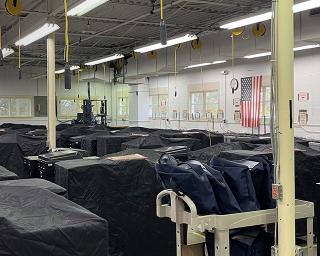Overview
All new voting systems are required to be certified by the State Board of Elections prior to counties purchasing and using the system. This ensures that all voting systems have been properly tested to confirm that they meet all applicable state and federal requirements. The State Board certifies any upgrades or modifications to voting systems. Such changes may not be used by a county until it has been certified by the State Board. Testing of machines occurs before, during, and after use to ensure accurate and secure results.
Escrowed Software
All certified software used by voting machines, systems, or equipment are held in escrow with the State Board of Elections. This ensures that all counties receive the software, and subsequent updates, for their machines from the same official source, and that it has been reviewed and certified for use in New York. Voting system software must be provided to Counties by the State Board; it may not be provided by the vendor directly to the county board.
Acceptance Testing
Before a County can use new voting machines, the machines must undergo acceptance testing. The voting system vendor delivers the new systems to a County so that the State can perform acceptance testing on-site at the County Board office. The State Board provides the County with the software required for the acceptance testing. After the County completes all configuration requirements, the certified software is installed to complete the acceptance testing process. While on-site, the State Board employee will also perform a hash check and will then demonstrate how to perform the hash check and other functional tests on the system, including scanning a test deck.
Re-examination and Decertification
When a voting machine vendor makes a change in an operation or material of any feature or component of a voting machine or system which has already been certified by the State Board, the modified machine or system must be submitted for re-examination and reapproval as the State Board of Elections deems necessary. If the State Board at any time has reason to believe that any certified machine or system does not meet all the requirements for voting machines or systems, it can have the machine or system re-examined. If the resulting report does not state that the machine or system can safely and properly be used by the voters at elections, the State Board will rescind its approval of the machine or system. After the approval has been rescinded, County Boards will not be able to purchase the machines or system, and all previously purchased machines or systems will need to be examined to determine whether they may continue to be used in elections.
Annual Maintenance
All voting machines are required to be tested at least once every calendar year. Counties accomplish this by rotating machines used at each election event so that all machines get deployed during the year. However, if there are any machines that do not get deployed, the machines will be tested by December 31st. The results for the pre-election testing for each machine is recorded on the maintenance log provided by the State Board.
Hash Check
A hash check is a test that compares the software running on the voting machine to the officially approved software currently held in escrow with the State Board. This ensures that there has been no tampering of the software loaded on to the voting machine. When the test is run, a series of characters will be produced at the end and if the characters produced by the machine matches the characters produced by the State Board, the machine has been verified to have the same software as the official copy held by the State Board. Hash checks need to be run on every machine on an annual basis.
Pre-Qualification Testing
If a voting system uses a touchscreen, push-button, or other electronic mechanism, a keypad or pneumatic switch, or alternative language displays, all need to be tested with the test deck to ensure they are working properly. All ballot configurations need to be tested, along with ballots that include write-in candidates, and ballots that are intended to fail. Ballots intended to fail include overvotes, undervotes, and no votes. Ballots where a candidate has been voted for on multiple lines needs to be tested to ensure the machine will count only the first vote for the candidate. If a machine does not pass the pre-qualification test and the error is identified and corrected, the test must be run and come back error-free twice in a row before the machine can be considered to have passed. Any machine that is unable to pass the test twice in a row cannot be used until the problem is identified, resolved, and has passed the test twice in a row.

